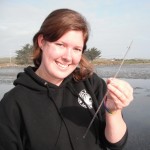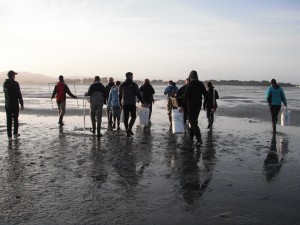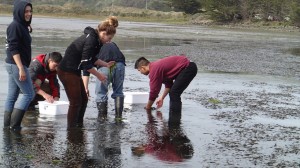Science boot-camp at the Bodega Marine Lab
by Julie Blaze (UC Davis undergraduate, ZENtern)
Marine biologists don’t often find themselves trekking through dense remote jungles or climbing desolate mountains to conduct their research. Some would say we’ve got it pretty easy – the ocean covers around 70% of the earth’s surface, and studying biodiversity can be as easy as walking out to the coast and digging in the sand. The only downside to the job is that we are captives to the ebb and flow of the tides. My classmates and I in the ZEN class at UCD found that out the hard way when we took a field trip to the Bodega Marine Laboratory to survey the eelgrass growing in Bodega Harbor.
As someone who enjoys sleep, I can honestly say it is difficult to wake up at 5:30 am for any reason. Awake before the sun and trudging across the mud flats before its first rays had even reached the water, I know I wasn’t the only one thinking of the warm, comfy beds we had left behind. My boots were a little too big and kept getting stuck in the mud – I almost went sprawling face down into the mud more than once. As the sun rose, I wondered what we must have looked like to anyone watching from the shore – a zombie-like group of college students floundering in the mud. Slowly we gained more energy and set about surveying a large expanse of the seagrass bed collecting samples and taking measurements. We worked efficiently and conversation picked up as excitement and adrenaline grew with each new discovery and lapping reminder of the incoming tide. At first glance the mudflats and seagrass meadows look barren, but we quickly found that they teemed with life. Critters clung to the grass or buried themselves in the mud – making this eelgrass bed, similar to other seagrass meadows, one of the most diverse ecosystems in the ocean.
After a few hours the water had crept too high for us to work and we headed back to the lab to begin processing our samples. We put in a long day, getting as much done as we could before calling it quits. We all found those cozy beds soon after a late dinner, with the promise of another early field day tomorrow.
The next morning we again rose before the sun and stumbled out into the mud. But this time we were more familiar with the science – the methodology and how to work as a team – and we finished before the water chased us out.
By the end of the weekend I was thoroughly exhausted, but I didn’t care. We had spent an incredible weekend having an amazing adventure. Not only did I learn about the animals and ecosystem we were exploring, but I also learned several things about myself that weekend. First, I learned that I am willing and able to wake up before the sun to do research. Second, not even the wilds of a remote jungle can tempt me away from the mysteries of the ocean. And, finally, one lesson I will never forget – it’s easy to stay awake once your boots flood with freezing cold seawater. But, it’s even easier when you’re also out exploring a location as interesting as a Bodega Bay seagrass bed!
Julie is a graduating senior at UC Davis majoring in Biology. This summer she will be a ZENtern working with Dr. Nessa O’Connor in Ireland. Julie is a true team player and earned the nickname “den mother” during the 3-day, marathon class field trip and subsequent weeks of sample processing back on campus.
Photos contributed by Aaron Goodman.





Comments are closed.